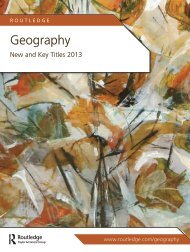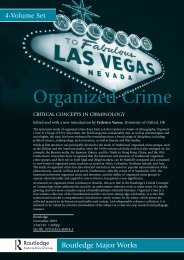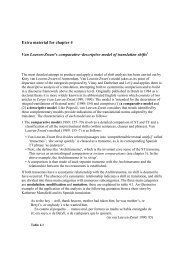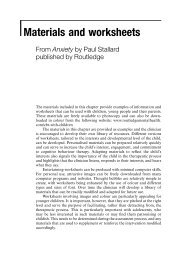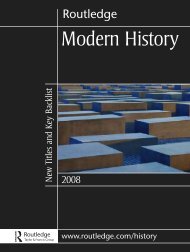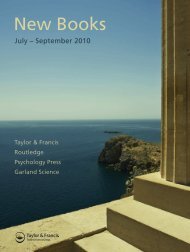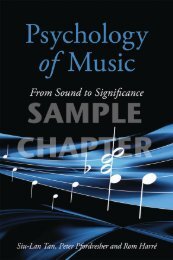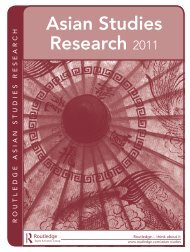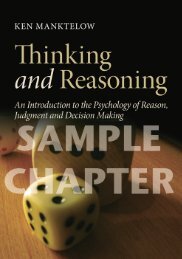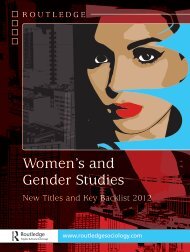Tim Burton: The Monster and the Crowd - A Post-Jungian Perspective
Tim Burton: The Monster and the Crowd - A Post-Jungian Perspective
Tim Burton: The Monster and the Crowd - A Post-Jungian Perspective
You also want an ePaper? Increase the reach of your titles
YUMPU automatically turns print PDFs into web optimized ePapers that Google loves.
12 Introduction<br />
<strong>the</strong> image (camera) <strong>and</strong> movement in <strong>the</strong> image (actors). 3 <strong>The</strong> fact that<br />
<strong>the</strong> `picture' moves is an additional bene®t ra<strong>the</strong>r than <strong>the</strong> main property<br />
of <strong>Burton</strong>'s creative product ± <strong>the</strong> movement allows him to tell a story,<br />
without foregrounding itself as a stylistic element. Much of his effort goes<br />
into <strong>the</strong> initial impression from <strong>the</strong> shot, hence <strong>the</strong> heightened attention<br />
to <strong>the</strong> static elements of <strong>the</strong> mise-en-sceÁne (<strong>the</strong> ones which cinema shares<br />
with photography): setting, decorations, texture, colours, lighting, framing,<br />
make-up <strong>and</strong> costumes. <strong>The</strong>y make <strong>Burton</strong>'s works highly atmospheric. His<br />
relative neglect of camera movement <strong>and</strong> editing gives his ®lms a charming<br />
imprecision ± which is perfect for <strong>Burton</strong>'s artistic purposes as this kind of<br />
background emphasises <strong>the</strong> magni®cent, luminous symbolism of his ®lms.<br />
<strong>Burton</strong>'s status in Hollywood is so ambiguous that some critics have<br />
altoge<strong>the</strong>r grouped his works with contemporary action movies, confusing<br />
his lack of narrative <strong>and</strong> stylistic precision with an interest in <strong>the</strong> action<br />
aspect of <strong>the</strong> ®lm. Alison McMahan, in a book entitled <strong>The</strong> Films of <strong>Tim</strong><br />
<strong>Burton</strong>, coins <strong>the</strong> term pataphysical ®lm, <strong>and</strong> irrevocably attributes <strong>Burton</strong>'s<br />
style to this genre. In her view, all pataphysical ®lms have in common <strong>the</strong><br />
following features:<br />
· An alternative narrative logic<br />
· Use of special effects in a blatant way<br />
· Thin plots <strong>and</strong> thinly drawn characters, `because <strong>the</strong> narrative relies<br />
more on intertextual, nondiegetic references'.<br />
(McMahan, 2005: 3)<br />
Examples of such movies include, for instance, Van Helsing (2004) <strong>and</strong><br />
Hulk (2003). It appears that <strong>the</strong> movies labelled pataphysical by Alison<br />
McMahan are predominantly commercial. <strong>The</strong>y privilege action over<br />
narrative <strong>and</strong> quite blatantly serve as a recycling factory for anything<br />
previously done in cinema, both stylistically <strong>and</strong> textually, mixing high <strong>and</strong><br />
low, old <strong>and</strong> new; r<strong>and</strong>omly combining genres, plots <strong>and</strong> recycled famous<br />
sequences from o<strong>the</strong>r ®lms. For instance, <strong>the</strong> seven-minute sequence at <strong>the</strong><br />
beginning of Van Helsing, incorporating segments from over 70 years of<br />
Draculas <strong>and</strong> Frankensteins, is not just an ironic statement, a reference that<br />
`got out of control'. It is ± decidedly ± an integral part of <strong>the</strong> movie.<br />
McMahan places <strong>the</strong> roots of this genre in <strong>the</strong> days of early cinema <strong>and</strong><br />
animation, Jules Levy's Les Art IncoheÂrents, <strong>and</strong> in <strong>the</strong> visual <strong>and</strong><br />
ideological legacy of Surrealism. She argues that <strong>the</strong> eccentric works of <strong>the</strong><br />
®rst animator, <strong>the</strong> French science teacher Emile Reynaud, 4 with <strong>the</strong>ir<br />
¯uidity of transformations, in¯uenced contemporary pataphysical ®lms.<br />
3 <strong>The</strong> last two are Metz's terms (Metz, 1974: 232).<br />
4 <strong>The</strong> director of Fantasmagorie (1908), <strong>The</strong> Hasher's Delirium (1910), etc.<br />
http://www.jungarena.com/tim-burton-<strong>the</strong>-monster-<strong>and</strong>-<strong>the</strong>-crowd-9780415489713



